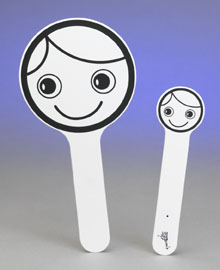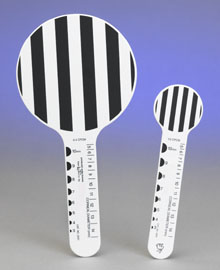 Fixation Targets
Fixation Targets
#253000 & #253100

![]()

The smallest fixation stick (#253000) in the test materials has a picture of a smiling face 5 cm (2 in) in diameter. This kind of happily smiling face was chosen based on the studies by Robert Fanz. Normally developing infants respond to it, follow it with combined eye and head movements at the age of three months. On the reverse side of the face there is a grating. In the examination of young infants turning the fixation stick gives the infant 'something new' to look at when the picture has been hidden for a few seconds. This fixation stick was designed in the early 1980s and has been used by thousands of public health nurses and doctors.
On the other end of the fixation stick there are small pictures of a bunny and of a giraffe. They are designed for the health care visit at the age of 3 years and later to have something that the child needs to accommodate carefully on to see the details of the images. By asking the child for example "Does the bunny have one or two ears? Does it move its tail? Does it look like the giraffe has four ears? Did you know that giraffes have horns between their ears?" one can keep the child's fixation on this accommodative target while assessing the alignment of the eyes.
On the handle of the fixation stick there are also pictures to be used in the measurement of the size of the pupils and the diameter of the corneas.
The larger (13 cm, 5 in) fixation picture (#253100) is for the assessment of severely visually impaired and multi-impaired children to define how far the infant or child responds to a high contrast face picture. This way there is a standardized picture for comparison of the child's behavior in different environments.
[ Instructions I Paediatric Vision Tests I Vision Tests ]
This document was last modified on